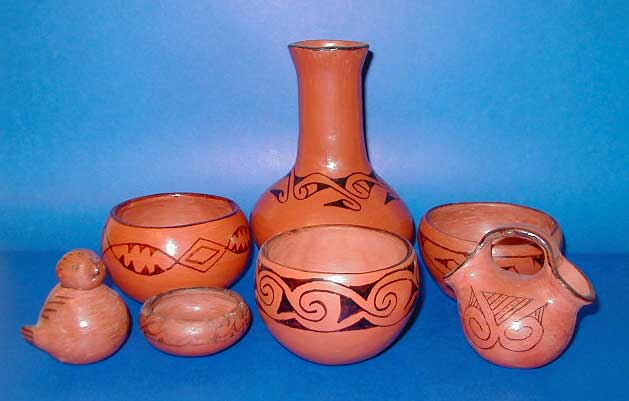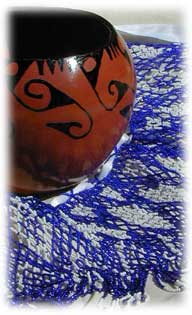 ClayHound Web
- Maricopa
Pottery
ClayHound Web
- Maricopa
PotteryReturn to:
|
Maricopa is located near Phoenix, Arizona. The pottery is distinguished by its dark red color. |
|
|
|
|
|
|
|
|
Maricopa Pottery
Though contemporary southwestern pottery styles are diverse, their production is rooted in cultural traditions unchanged since prehistoric times. As long as 2000 years ago, the Hohokam inhabited much of what is now south central Arizona. They prospered here through about AD 1450. By the late 1600s, according to Spanish accounts, this area was home to other people. Little is known from the archaeological record about the intervening years. However, oral traditions of the O’odham speak of ties to the ancient Hohokam. Examination of prehistoric Hohokam pottery lends support to these oral traditions. Although artistic forms have changed, it appears that the methods of pottery manufacture have not changed much in nearly 2000 years. By the 1700s, south-central Arizona was home to the Akimel O’odham, (Pima) along the Gila River, the Tohono O’odham (Papago) to the south, and the different tribes of Yuman-speaking people to the southwest. Some of these Yuman people, the Piipash (Maricopa), moved steadily eastward along the Gila, settling among the Akimel O’odham by the mid-1800s. The two tribes, although separated by language, were united in their mutual defense, and in many aspects of their culture. The pottery produced by Piipash and O'odham artisans during the rest of the century is correspondingly similar. Through the 1800's, Southwestern potters invested most of their time and skill in making pottery for everyday use. Ceramic containers were needed for water and food storage, and for cooking. Later, as commercially produced containers came into southwestern markets, potters needed to make fewer functional vessels. They began to explore new vessel forms, some designed for commercial sale to tourists. New pottery forms and styles continue to be explored. Artistic traditions, passed down through the generations, are represented today at the Salt River Pima-Maricopa Indian Community, the Gila River Indian Community, the Ak-Chin Indian Community, and the Tohono O’odham Nation. ---------------------------- The Halchidhoma Maricopa or Pi-posh
women near Lehi, Arizona constructed clay pottery for sale to Anglo
settlers, and eventually these items evolved into popular tourist
souvenir items. The styles and forms of pottery underwent several
revivals, as standards for design and techniques of production
improved to meet consumer tastes. Today, the resulting red and black
designs combined with cream slip and scroll line pots are recognized
as the distinctive Maricopa style. Other pottery styles include human
effigy pots and animal effigy pots reflecting the desert fauna of the
Salt River landscape. |
|
|
From:
http://www.saltriver.pima-maricopa.nsn.us/maricopa.html |
|



 The
Maricopa people were small bands living along the lower Gila and
Colorado rivers. Each of these bands migrated eastward at different
times. The Xalichidom (Maricopa of Lehi), left around 1825-1830. The
last of these bands is said to have left the Colorado River in the
late 1830's. Eventually these bands came together and became
collectively known as the Maricopa. As they migrated eastward, they
came upon the Pima tribe and established a relationship. Both tribes
provided protection against the Yuman and Apache tribes.
The
Maricopa people were small bands living along the lower Gila and
Colorado rivers. Each of these bands migrated eastward at different
times. The Xalichidom (Maricopa of Lehi), left around 1825-1830. The
last of these bands is said to have left the Colorado River in the
late 1830's. Eventually these bands came together and became
collectively known as the Maricopa. As they migrated eastward, they
came upon the Pima tribe and established a relationship. Both tribes
provided protection against the Yuman and Apache tribes.